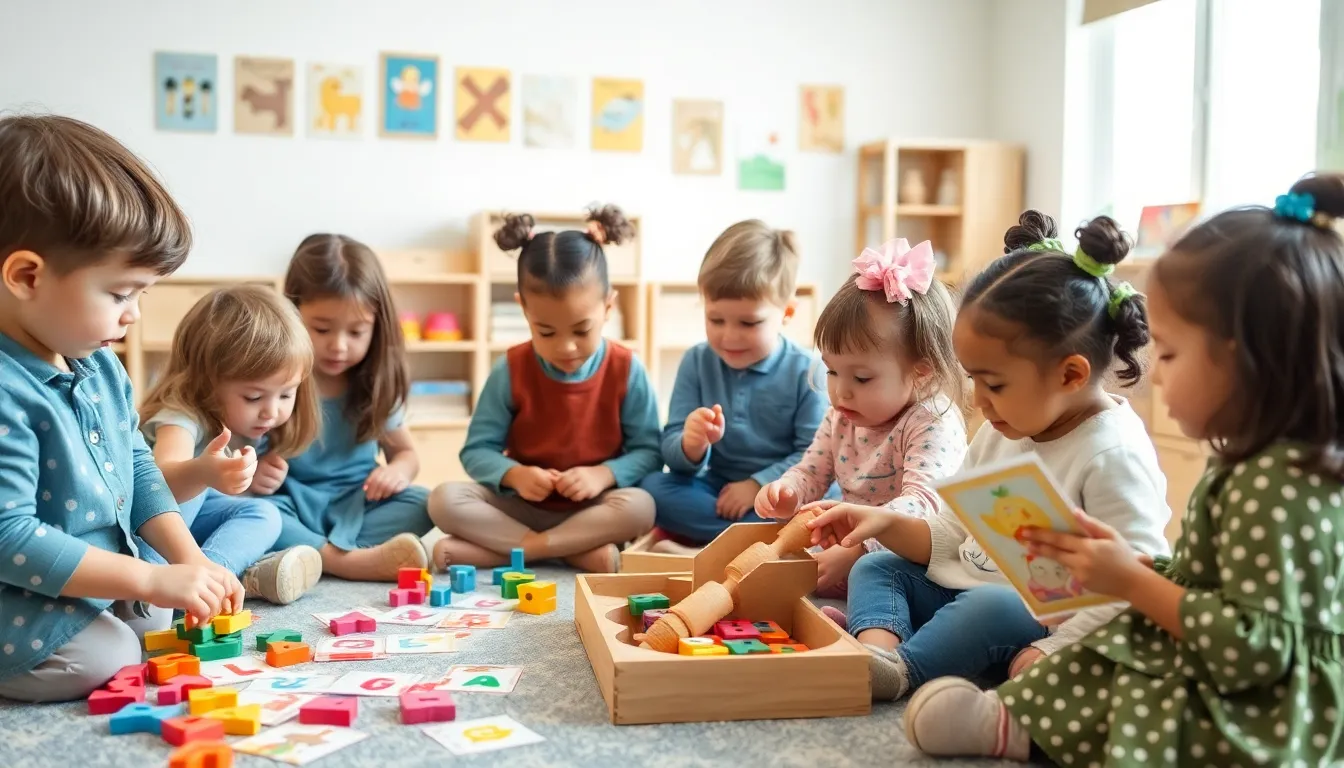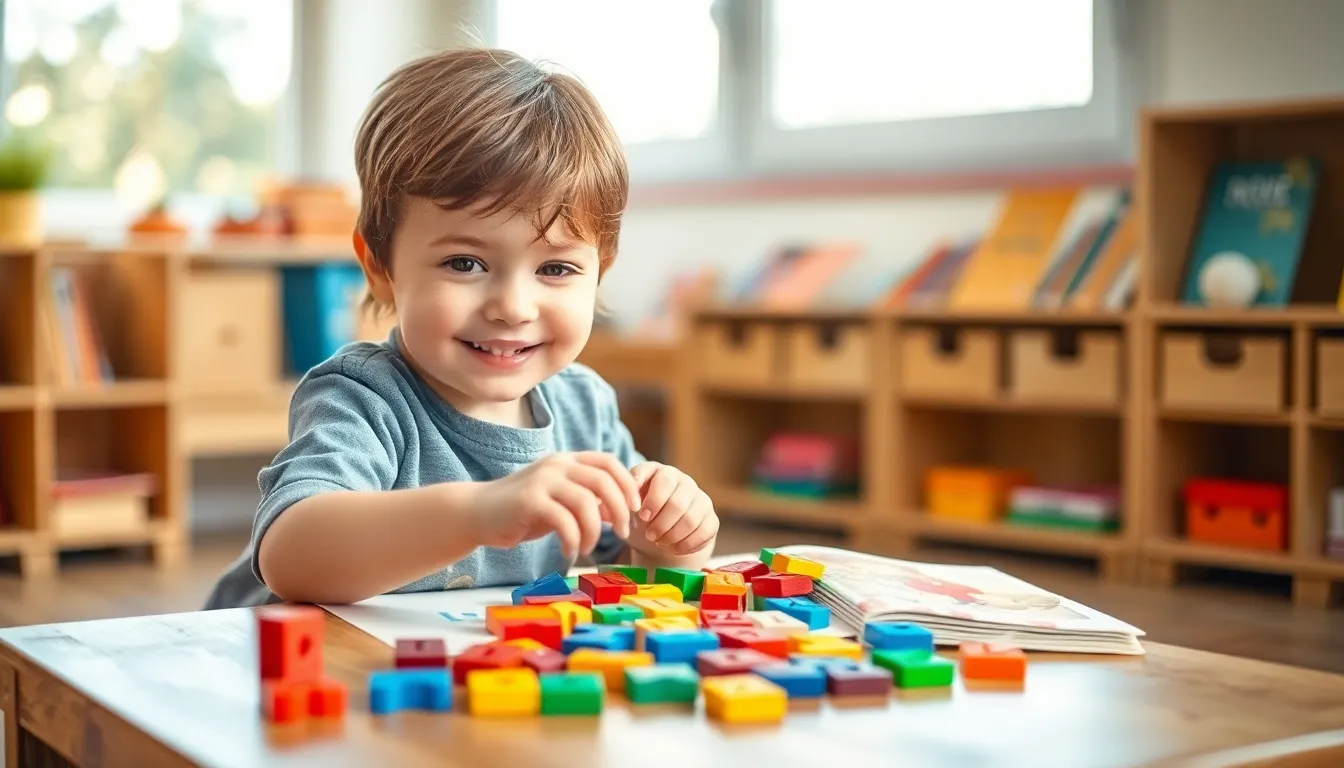In a world where kids are glued to screens, Montessori reading materials offer a refreshing escape into the realm of imagination and learning. These hands-on tools don’t just teach children to read; they turn the process into an adventure that sparks curiosity and creativity. Imagine a child discovering the joy of words through tactile letters and engaging stories instead of scrolling through endless cat videos.
Montessori materials are designed to cater to a child’s natural learning instincts. They make reading feel less like a chore and more like a treasure hunt. With vibrant colors and interactive elements, these resources invite kids to dive into books with enthusiasm. Who knew that the path to literacy could be paved with such fun? Montessori reading materials transform the reading experience, making it not just educational but downright enjoyable.
Table of Contents
ToggleOverview of Montessori Reading Materials
Montessori reading materials serve as essential tools to engage children during their literacy journey. These resources provide a hands-on approach, making the reading process enjoyable and effective.
The Montessori Method Explained
The Montessori Method emphasizes self-directed learning. Children explore at their own pace, allowing them to develop critical thinking skills. Reading materials align with this philosophy by offering tactile experiences, such as wooden letters and textured books. These tools facilitate sensory exploration, helping children connect sounds and symbols. Educators encourage children to choose their materials, fostering independence and motivation. Practical activities centered on reading create an engaging atmosphere where learning flourishes.
Importance of Reading in Montessori Education
Reading holds a significant place in Montessori education. It enhances cognitive development and language acquisition. Children exposed to reading early show improved vocabulary and comprehension skills. Montessori materials, which include picture books and movable alphabets, support diverse learning styles. By using these resources, children develop a love for reading that transcends the classroom. Encouragement of storytelling and imaginative play enriches their learning experience, creating a strong foundation for future literacy. Ultimately, reading becomes an essential part of children’s growth and understanding of the world around them.
Types of Montessori Reading Materials

Montessori reading materials come in various forms, each designed to enhance specific aspects of literacy. Understanding these types helps educators and parents select the right resources for children.
Phonetic Materials
Phonetic materials promote sound recognition. These tools include wooden letters, movable alphabets, and phonetic cards. Children manipulate these items to associate sounds with symbols, enhancing their phonemic awareness. Engaging with tactile resources fosters sensory exploration while building a foundation for reading skills. Phonetic materials also encourage independent learning, allowing children to progress at their own pace.
Vocabulary Development Tools
Vocabulary development tools support language acquisition through interactive experiences. Flashcards, illustrated word books, and language games facilitate word recognition and usage. Children encounter diverse vocabulary in engaging contexts, which aids in retention and understanding. These tools also inspire conversations and enrich language skills, fostering confidence as children express ideas. A varied range of vocabulary expands their communication abilities, crucial for literacy success.
Reading Comprehension Resources
Reading comprehension resources enhance understanding of text. Materials such as story sequencing cards, comprehension questions, and visual aids guide children through narratives. Engaging with these resources cultivates critical thinking skills while nurturing curiosity about stories. Children learn to make connections and infer meanings, improving their overall reading experience. Variety in comprehension tools caters to different learning styles, ensuring all children can grasp concepts effectively.
Benefits of Montessori Reading Materials
Montessori reading materials offer unique advantages that support children’s literacy development. These materials promote hands-on engagement and individualized learning experiences.
Fostering Independence
Independence flourishes through Montessori reading materials. Children select their reading tools and explore at their own pace. This self-directed approach cultivates decision-making skills. Engaging with materials like movable alphabets allows learners to create words autonomously. Such freedom encourages problem-solving and critical thinking. Mastering new concepts becomes a personal achievement, enhancing self-esteem and confidence. Ultimately, children gain valuable skills that extend beyond literacy.
Encouraging Love for Learning
A love for learning emerges naturally when children interact with Montessori reading materials. Vibrantly colored tools and interactive elements spark curiosity and enthusiasm. Engaging with textured books and phonetic materials makes learning enjoyable. As children explore stories, they connect with characters and plotlines, fostering their imagination. Exposure to various genres and topics broadens their awareness of the world. This excitement for discovery lays the foundation for a lifelong passion for literacy and education.
How to Choose Montessori Reading Materials
Selecting the right Montessori reading materials ensures a child’s effective literacy development. Prioritizing specific criteria enhances their learning experience.
Age Appropriateness
Consider the child’s developmental stage when choosing reading materials. Each age group benefits from tailored resources that match their cognitive abilities. For children aged 3 to 5, simple picture books facilitate vocabulary growth and basic comprehension. Materials featuring phonetic sounds appeal to those aged 5 to 7, helping solidify reading skills. As children progress to ages 7 to 9, chapter books and more complex texts foster deeper understanding and critical thinking. Integrating age-appropriate resources guarantees engagement while promoting a love for reading.
Curriculum Alignment
Ensure reading materials align with the Montessori curriculum for optimal learning. Montessori emphasizes individualized learning that connects with children’s interests. Materials should reflect themes found in the classroom, such as nature, culture, and science. The incorporation of diverse formats like storybooks, non-fiction texts, and poetry enhances various learning styles. Selecting resources that support classroom topics reinforces knowledge retention while encouraging exploration. Mapping reading materials to the curriculum creates a cohesive educational experience.
Montessori reading materials play a crucial role in nurturing a child’s literacy journey. By providing hands-on tools that engage the senses and foster independence, these resources create an environment where learning becomes a joyful adventure. Children not only develop essential reading skills but also cultivate a genuine love for literature.
The thoughtful design of these materials supports various learning styles and developmental stages, ensuring that each child can thrive at their own pace. As they explore stories and concepts through interactive elements, they build confidence and critical thinking abilities. Embracing Montessori reading materials is a powerful step towards fostering a lifelong passion for reading and learning in every child.



